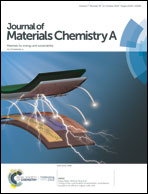An inorganic salt reinforced Zn2+-conducting solid-state electrolyte for ultra-stable Zn metal batteries†
Abstract
The rapid development of flexible and wearable electronics calls for advanced batteries with high safety, long cycling stability, and low cost. Aqueous Zn metal batteries (ZMBs) are some of the most promising candidates. The main challenges are the water-induced parasitic reactions (corrosion and passivation) and dendrite-driven battery failure in traditional liquid electrolytes. Developing new electrolyte systems is critical to overcoming these issues. Herein, an ultrastrong self-standing gelatin-based solid-state electrolyte (GSE) formed by strong hydrophobic interaction between gelatin molecule chains is first introduced for stable solid-state ZMBs. The GSEs prepared by a facile soaking strategy contain much less free water compared to conventional electrolyte systems and exhibit the highest fracture tensile strength of 2.78 MPa among the reported self-standing single-component solid-state electrolytes for ZMBs, which effectively inhibit the corrosion/passivation reaction and enable the Zn/Zn symmetric cells to stably cycle at hitherto the highest current density of 5 mA cm−2 with record high cumulative plating/stripping capacity. Meanwhile, the solid-state Zn/MnO2 full cell can deliver a high reversible specific capacity of 285 mA h g−1, superior cycling stability (90% capacity retention/500 cycles), and excellent safety under extreme working circumstances. The impressive performance sheds light on the design and applications of robust solid-state electrolytes for ZMBs.



 Please wait while we load your content...
Please wait while we load your content...